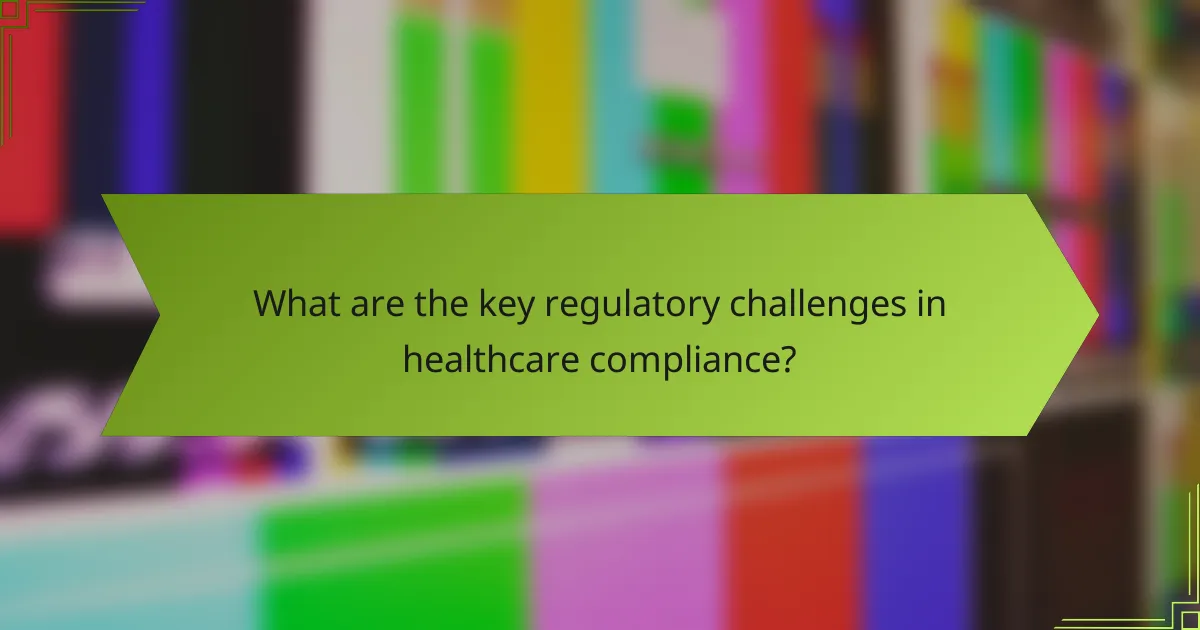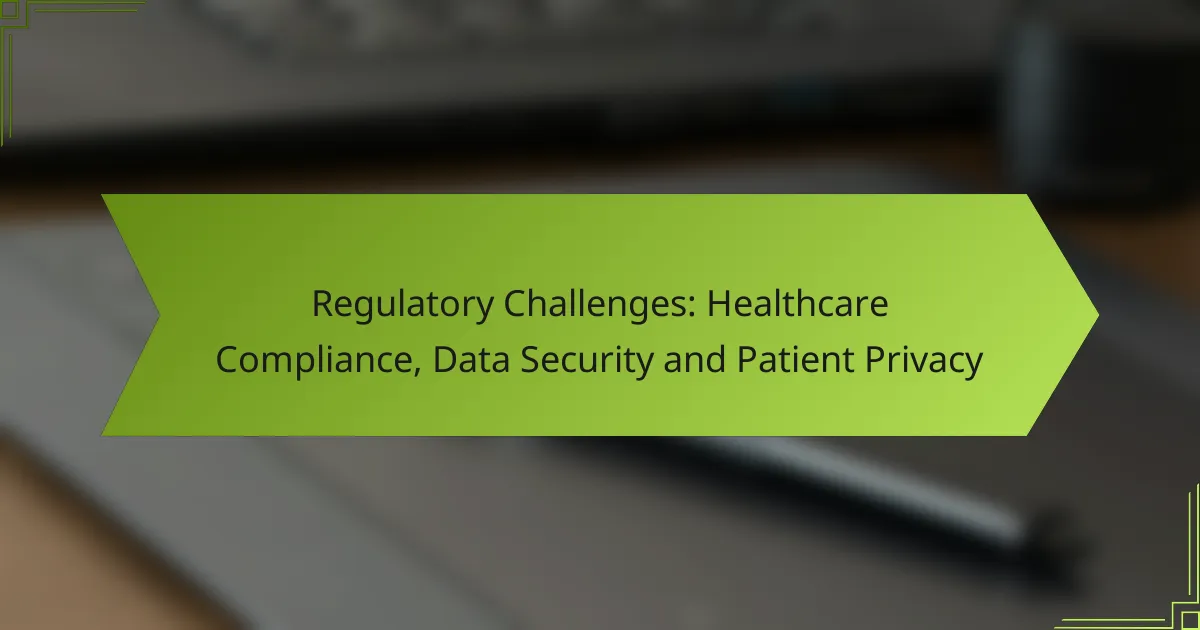Healthcare organizations face significant regulatory challenges in compliance, particularly in navigating complex regulations and adapting to frequent updates. Ensuring data security and maintaining patient privacy are critical components of this landscape, requiring a multi-layered approach that includes encryption, audits, and employee training. By effectively managing these challenges, organizations can protect sensitive patient information and uphold trust in the healthcare system.

What are the key regulatory challenges in healthcare compliance?
The key regulatory challenges in healthcare compliance include navigating complex regulations, adapting to frequent updates, integrating technology, managing resource constraints, and addressing cross-border compliance issues. These factors create a dynamic environment that healthcare organizations must continuously monitor and adapt to in order to maintain compliance and protect patient privacy.
Complexity of regulations
Healthcare regulations are often intricate and vary significantly across jurisdictions. Organizations must understand a multitude of laws, such as HIPAA in the United States or GDPR in Europe, which govern patient data protection and privacy. The complexity increases as regulations may overlap or conflict, requiring careful navigation to ensure compliance.
To manage this complexity, healthcare providers should invest in compliance training and legal expertise. Regular audits can help identify gaps in understanding and adherence to relevant regulations.
Frequent updates and changes
Regulatory frameworks in healthcare are subject to frequent updates, which can create challenges for compliance. Changes may arise from new legislation, amendments to existing laws, or shifts in governmental policy. Staying informed about these changes is crucial for maintaining compliance.
Healthcare organizations should establish a system for monitoring regulatory updates, such as subscribing to industry newsletters or joining professional associations. This proactive approach can help mitigate risks associated with non-compliance.
Integration of technology
The integration of technology in healthcare, including electronic health records (EHRs) and telemedicine, poses unique compliance challenges. While technology can enhance efficiency and patient care, it also raises concerns about data security and patient privacy. Ensuring that technology solutions comply with regulations is essential.
Organizations should conduct thorough assessments of technology vendors to ensure they meet compliance standards. Implementing robust cybersecurity measures and regular training for staff on data protection can further safeguard patient information.
Resource constraints
Many healthcare organizations face resource constraints that hinder their ability to maintain compliance. Limited budgets and staff can lead to insufficient training, inadequate technology, and a lack of dedicated compliance personnel. This can increase the risk of non-compliance and potential penalties.
To address resource challenges, organizations can prioritize compliance initiatives based on risk assessments. Collaborating with external compliance experts or utilizing compliance management software can also help optimize resources.
Cross-border compliance issues
For healthcare organizations operating internationally, cross-border compliance presents significant challenges. Different countries have varying regulations regarding data protection, patient rights, and healthcare practices, making it difficult to ensure compliance across jurisdictions.
Organizations should develop a comprehensive understanding of the regulatory landscape in each country they operate in. Engaging local legal experts can provide valuable insights and help navigate the complexities of cross-border compliance effectively.

How can healthcare organizations ensure data security?
Healthcare organizations can ensure data security by implementing a multi-layered approach that includes encryption, regular audits, employee training, and secure cloud services. These strategies help protect sensitive patient information from unauthorized access and breaches.
Implementing encryption protocols
Encryption protocols are essential for safeguarding patient data both at rest and in transit. By converting sensitive information into unreadable code, organizations can prevent unauthorized access even if data is intercepted. Common encryption standards include AES (Advanced Encryption Standard) and TLS (Transport Layer Security).
Healthcare organizations should ensure that all electronic health records (EHRs) and communications are encrypted. Regularly updating encryption methods and key management practices is crucial to maintaining security against evolving threats.
Regular security audits
Conducting regular security audits helps healthcare organizations identify vulnerabilities in their systems. These audits should assess both technical controls and administrative practices to ensure compliance with regulations like HIPAA in the U.S. or GDPR in Europe.
Organizations should schedule audits at least annually and after any significant system changes. Engaging third-party security experts can provide an unbiased assessment and help implement necessary improvements.
Employee training programs
Employee training programs are vital for fostering a culture of security awareness within healthcare organizations. Staff should be educated on data protection policies, recognizing phishing attempts, and secure handling of patient information.
Regular training sessions, ideally quarterly, can reinforce best practices and keep employees updated on new threats. Utilizing real-world scenarios during training can enhance understanding and retention of security protocols.
Utilizing secure cloud services
Utilizing secure cloud services allows healthcare organizations to store and manage patient data with enhanced security features. Many cloud providers offer built-in encryption, access controls, and compliance certifications that align with healthcare regulations.
When selecting a cloud service, organizations should evaluate the provider’s security measures, data recovery options, and compliance with relevant regulations. A hybrid cloud approach can also be considered, balancing on-premises and cloud solutions for optimal security and flexibility.

What are the best practices for maintaining patient privacy?
Maintaining patient privacy involves implementing robust strategies to safeguard personal health information. Key practices include adhering to regulations, minimizing data collection, managing consent effectively, and controlling access to sensitive information.
Adopting HIPAA compliance measures
Adopting HIPAA compliance measures is essential for healthcare organizations in the United States to protect patient privacy. This includes ensuring that all electronic health records (EHRs) are secure, conducting regular risk assessments, and training staff on privacy policies. Non-compliance can lead to significant fines and damage to reputation.
Organizations should implement administrative, physical, and technical safeguards as outlined by HIPAA. Regular audits and updates to compliance protocols help maintain adherence to evolving regulations.
Data minimization strategies
Data minimization strategies focus on collecting only the information necessary for healthcare delivery. This approach reduces the risk of exposure and misuse of sensitive data. For instance, instead of gathering extensive personal details, providers can limit data collection to what is essential for treatment.
Implementing data retention policies is also crucial. Organizations should regularly review and securely dispose of data that is no longer needed, ensuring that only relevant information is kept on file.
Patient consent management
Effective patient consent management is vital for maintaining privacy and building trust. Healthcare providers should ensure that patients are fully informed about how their data will be used and obtain explicit consent before sharing any information. This can be facilitated through clear consent forms and discussions during appointments.
Regularly updating consent practices to reflect changes in regulations or organizational policies is important. Providers should also offer patients easy options to withdraw consent if they choose to do so.
Access control mechanisms
Access control mechanisms are critical for protecting patient information from unauthorized access. Implementing role-based access ensures that only authorized personnel can view or modify sensitive data. This can include using unique user IDs and passwords, along with two-factor authentication for additional security.
Regularly reviewing access logs and permissions can help identify any potential breaches or unauthorized attempts to access patient information. Training staff on the importance of access controls is also essential to foster a culture of privacy within the organization.

What frameworks can guide healthcare compliance efforts?
Healthcare compliance efforts can be effectively guided by established frameworks that provide structured approaches to managing data security and patient privacy. Utilizing these frameworks helps organizations align with regulatory requirements while enhancing their overall security posture.
ISO 27001 standards
ISO 27001 is an international standard that outlines the requirements for an information security management system (ISMS). It helps healthcare organizations systematically manage sensitive patient data, ensuring confidentiality, integrity, and availability.
To implement ISO 27001, organizations should conduct a risk assessment, establish security controls, and regularly review and improve their ISMS. This standard is particularly beneficial for organizations aiming to demonstrate compliance with data protection regulations.
NIST Cybersecurity Framework
The NIST Cybersecurity Framework provides a flexible approach for organizations to manage and reduce cybersecurity risk. It consists of five core functions: Identify, Protect, Detect, Respond, and Recover, which help healthcare entities create a comprehensive security strategy.
Healthcare organizations can adopt this framework by assessing their current cybersecurity posture, implementing necessary safeguards, and developing incident response plans. Regular training and updates are crucial to adapt to evolving threats and maintain compliance with healthcare regulations.

How do regulatory challenges vary across different regions?
Regulatory challenges in healthcare compliance, data security, and patient privacy differ significantly across regions due to varying laws and cultural attitudes towards privacy. Understanding these differences is crucial for healthcare providers operating in multiple jurisdictions.
Differences in GDPR vs HIPAA
The General Data Protection Regulation (GDPR) in Europe and the Health Insurance Portability and Accountability Act (HIPAA) in the United States both aim to protect personal data but do so in different ways. GDPR applies to all personal data, emphasizing individual consent and data portability, while HIPAA specifically addresses health information, focusing on the confidentiality and security of medical records.
GDPR imposes strict penalties for non-compliance, which can reach up to 4% of annual global turnover or €20 million, whichever is higher. In contrast, HIPAA violations can result in fines ranging from thousands to millions of dollars, depending on the severity and nature of the breach.
Regional healthcare laws in the US
In the United States, healthcare laws vary by state, creating a complex regulatory landscape. Each state may have its own privacy laws that complement or enhance HIPAA, such as California’s Confidentiality of Medical Information Act (CMIA), which provides additional protections for patient data.
Healthcare providers must navigate these regional laws carefully to ensure compliance. For example, some states require patient consent for sharing medical information even when HIPAA does not, which can complicate data sharing practices. Regular training and legal consultations are recommended to stay updated on local regulations.

What emerging trends are shaping healthcare compliance?
Emerging trends in healthcare compliance are primarily driven by advancements in technology, regulatory changes, and an increasing focus on patient-centered care. These trends include the integration of artificial intelligence, stricter data protection laws, and a shift towards value-based care models.
Increased focus on data security and patient privacy
Data security and patient privacy are becoming top priorities for healthcare organizations due to rising cyber threats and regulatory scrutiny. Healthcare providers must implement robust cybersecurity measures to protect sensitive patient information from breaches, which can lead to significant financial penalties and loss of trust.
Organizations should adopt encryption, multi-factor authentication, and regular security audits as part of their data protection strategies. Additionally, staff training on data handling practices is essential to minimize human error, which is a common vulnerability.
Adoption of telehealth and remote monitoring
The rapid adoption of telehealth services has transformed healthcare delivery, necessitating new compliance frameworks. Providers must ensure that telehealth platforms comply with existing regulations, such as HIPAA in the United States, to safeguard patient data during virtual consultations.
Healthcare organizations should evaluate their telehealth solutions for compliance with security standards and ensure that patients are informed about their privacy rights. Regular assessments and updates to telehealth policies are crucial as technology and regulations evolve.
Value-based care models
Value-based care models emphasize patient outcomes over service volume, which requires a shift in compliance strategies. Organizations must track and report on quality metrics to demonstrate the effectiveness of their care delivery, aligning with payer requirements and regulatory standards.
To succeed in this environment, healthcare providers should invest in data analytics tools that facilitate the monitoring of patient outcomes. Establishing clear communication channels with payers and adapting to changing reimbursement models are also vital for compliance in value-based care.
